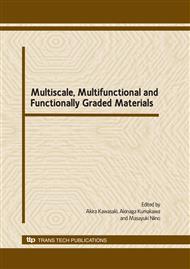p.103
p.109
p.115
p.121
p.127
p.135
p.141
p.149
p.155
The Effective Conductivity of Multiphase Composites with Imperfect Thermal Contact at Constituent Interfaces
Abstract:
This paper studies the effective thermal conductivity of multiphase composite in which a thermal boundary resistance exists at constituent interfaces. Based on the theoretical framework of conductivity for binary system composites in the presence of a thermal contact resistance between matrix and inclusion given by Y. Benveniste and T. Miloh (1986), the fundamental concept is generalized for the case of multiphase composites with imperfect contact which permits a temperature discontinuity between matrix and inclusions of different phases. A micromechanics model, the “generalized self-consistent scheme (GSCS)” based on a particle-matrix embedding in the effective medium, is generalized to evaluate the effective conductivity of multiphase medium with imperfect thermal contact at constituent interfaces. Numerical results are given for three-phase particulate composites with spherical particles to illustrate the effect of imperfect interfaces on the effective thermal conductivity of multiphase composites.
Info:
Periodical:
Pages:
127-132
Citation:
Online since:
October 2009
Authors:
Price:
Сopyright:
© 2010 Trans Tech Publications Ltd. All Rights Reserved
Share:
Citation:


